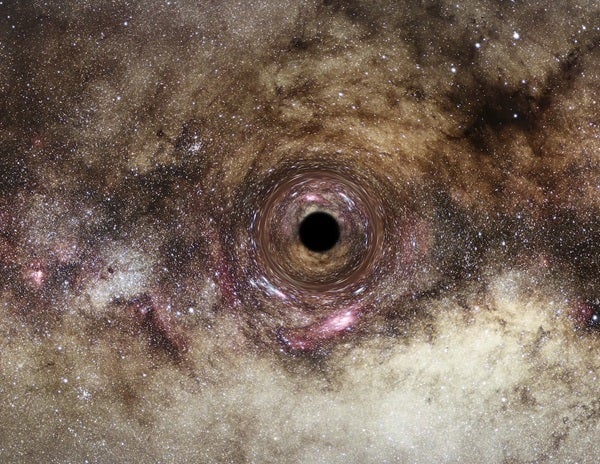
On a cool evening in a small village in India, a man sat with his son and stared up at the night sky, as was their habit after dinner. Since the village had no electricity, the stars shone extra bright against the inky backdrop of space. The two spoke of stellar motions, and the young boy soon developed a fascination for astronomy.
Neither of them knew then that this fascination would one day dramatically advance our understanding of the cosmos. A few decades later, in 2022, Kailash Sahu — the young boy from India — would lead a team to discover the first known “rogue” black hole.
Although it’s been more 50 years since the first detection of a black hole, these objects are still more ommonly theorized about than observed. Astronomers have identified just a few dozen stellar-mass black holes in our galaxy — and only then because they are in binary systems, pulling material from a still-shining companion star. And these may be the extreme exceptions, not the rule. Most of the 100 million or so black holes thought to exist in the Milky Way drift through space alone, quiescent, dark, and impossible to spot directly.
But with Sahu’s discovery of such a rogue black hole, astronomers have begun to uncover that vast unseen majority, promising a revolution in the field and insight into the objects’ origins.
Black holes 101
The idea of an object whose gravity is so strong that not even light can escape its grasp was first introduced by John Mitchell in the late 1700s. However, such objects were long thought to be a mathematical quirk that had little to do with reality. Karl Schwarzschild, a German physicist and astronomer, further developed the mathematical concept of black holes in 1916 after working through Einstein’s equations of relativity. But for decades, most experts didn’t think they could actually form. The English astronomer Arthur Eddington once said, “I think there should be a law of nature to prevent a star from behaving in this absurd way!”
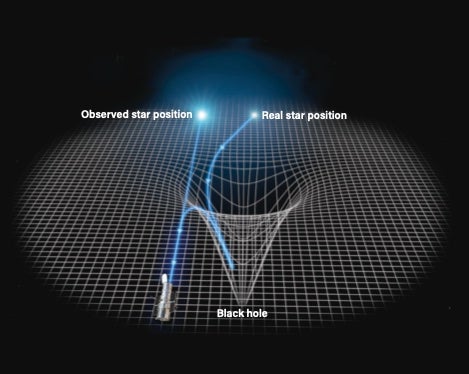
It’s easy to see why astronomers took some time to get on board. Black holes are some of the most bizarre objects in the cosmos, throwing our earthly concepts of space and time right out the window. Each one packs the mass of an entire star (or many stars) into a vanishingly small space called a singularity. Surrounding it is the event horizon — the boundary of no return, inside which even the speed of light isn’t fast enough to escape the pull of gravity. The size of a black hole — i.e., the distance of the event horizon from the singularity — depends on the mass of the black hole.
It gets even stranger. Einstein taught us that space and time are interlocked; warping one warps the other too. As a result, time moves more and more slowly the deeper you get in the gravitational well of any massive object, be it a star or a black hole. But black holes are uniquely odd: Once you reach the event horizon, time screeches to a halt, as viewed by an outside observer. (For the unfortunate individual falling into the black hole, time marches on.) Because of this, some physicists originally called black holes “frozen stars” and presumed that such mind-bending objects couldn’t be real.
You might understand, then, how physicists reacted with widespread skepticism when the first black hole was discovered. The journey began in 1964, when a sounding rocket experiment detected an unseen object emitting lots of X-rays. That fit the profile of a black hole, around which infalling gas grows extremely hot — so hot that it emits X-rays before ultimately falling past the event horizon.
The object, dubbed Cygnus X-1, or Cyg X-1 for short, was in a binary system with a companion star. That binary nature allowed astronomers to determine the mass of the unseen object by applying Kepler’s laws of motion to the visible star. Based on the results, they realized there was no other alternative — it could only be a black hole. Scientists were forced to accept that these ghostly goliaths were real after all.
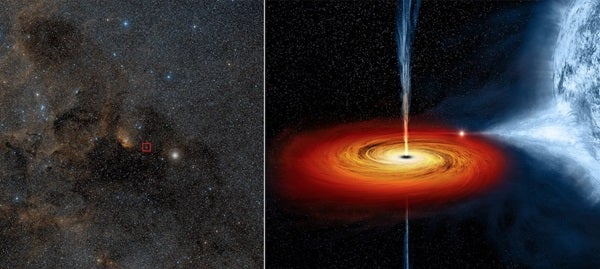
A ‘rogue’ black hole
Today, scientists think our galaxy is teeming with millions of black holes born from the collapse of massive stars. But since they’re invisible, astronomers have only been able to detect a few — around 20 to date — thanks to the presence of companion stars. That is, until July 2022.
That’s when a team of scientists led by Sahu, now an astronomer at the Space Telescope Science Institute in Baltimore, published the first-ever confirmed detection of a stellar-mass black hole that’s completely alone. Their results, which appeared in The Astrophysical Journal, raise the possibility of finding more of the estimated 100 million such rogue stellar-mass black holes drifting through our galaxy unseen.
Located about 5,200 light-years away toward the center of our galaxy, the yet-to-be-named rogue black hole weighs in at just over seven times the Sun’s mass. It’s also moving along at some 28 miles (45 kilometers) a second, faster than nearly all the stars in the region.
That speed hints at how it formed. Scientists think that when a massive star runs out of fuel and collapses into either a neutron star or a black hole, the supernova explosion it experiences may be uneven. “This black hole seems to have gotten a natal kick at birth that sent it speeding away” from any nearby stars, says Sahu.
Confirming the rogue
A team led by Casey Lam and Jessica Lu of the University of California, Berkeley, published a study including the same rogue black hole candidate in July 2022 in The Astrophysical Journal Letters. They found the object was between 1.5 and 4 solar masses — possibly light enough to be a neutron star. However, another July 2022 paper in The Astrophysical Journal indicated its lack of X-rays disfavored a neutron star. And an independent analysis published in October 2022 in The Astrophysical Journal Letters is consistent with Sahu’s mass, further clinching the case for a rogue black hole. – Alison Klesman
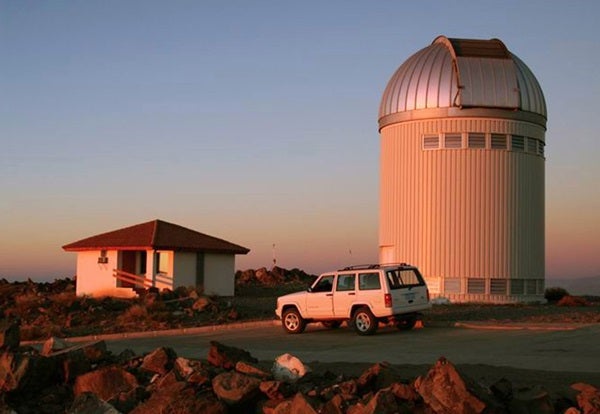
Seeing the unseeable
This discovery was the culmination of six years of observations and two different techniques.
First, Sahu’s team looked in the galactic center for stars that grew temporarily brighter because of an effect called microlensing. We know that massive objects warp the fabric of space-time around them. When a heavy object passes in front of a more distant star along our line of sight, the background starlight bends as it travels past the closer object. This both distorts the observed position of the star from our point of view and acts as a natural magnifying glass, brightening the star’s light.
The phenomenon is called gravitational lensing, or microlensing when the foreground object, or lens, is small (like a star, neutron star, or black hole). Astronomers can roughly estimate the mass of the lens by watching how long the spike in starlight lasts; heavier objects create longer microlensing events.
Two ground-based telescopes, the Optical Gravitational Lensing Experiment (OGLE) in Chile and Microlensing Observations in Astrophysics (MOA) telescope in New Zealand, initially picked up the microlensing event, since cataloged as MOA-11-191/OGLE-11-462. It lasted long enough — 270 days over 2011 and 2012 — that astronomers suspected the lens could be a black hole.
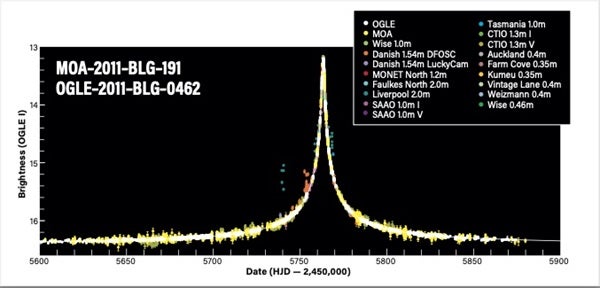
But a black hole can’t be confirmed by microlensing alone. A small, faint star can masquerade as a heavier object if it is moving slowly; it, too, would produce a long signal due to its slow speed, and if it’s dim enough, astronomers might only detect light from the background star.
That’s where astrometry — making precise measurements of an object’s position — comes in. By seeing how much the background star appears to shift during a microlensing event, astronomers can more accurately determine the mass of the lens.
The team spent six years watching and analyzing the astrometric signal, which in general can last five to 10 times longer than its microlensing counterpart. The deflection of the background star’s position reached a maximum of about 0.002″ — some 30 times less than the smallest Pluto can appear from Earth. Only the Hubble Space Telescope is capable of detecting a deflection that minute. But it was large enough to indicate that the foreground object was “so massive that if it were a star, it would be shining brightly; yet, we detected no light from it at all,” says Sahu. “That’s how we knew we found a black hole.”
“It’s extremely gratifying to be part of such a monumental discovery,” he says. “I’ve been searching for rogue black holes for more than a decade, and it’s exciting to finally find one! I hope it will be the first of many.”
Those future finds may come from NASA’s Nancy Grace Roman Space Telescope, planned to launch by 2027. The observatory will stare toward the heart of our galaxy, where stars are packed close together, looking for microlensing signals like the one Sahu’s team spotted. This survey will reveal a host of unseen objects, from planets orbiting stars to potentially more rogue black holes.
Any additional detections will help astronomers understand stellar-mass black holes in ways they can’t from just the couple of dozen that are currently known. Just as an online shopper gains confidence from a high number of product reviews, astronomers want to gather a statistical sample that more accurately represents what stellar-mass black holes are like as a group.
That’s especially important because some astronomers think the ones found in binary systems may represent a biased sample. Their masses only range from about five to 20 times the Sun’s mass, with most (including the newly discovered rogue black hole) weighing in at around 7 solar masses. But the true range may be much broader.
“Stellar-mass black holes that have been detected in other galaxies via gravitational waves are often far larger than those we’ve found in our galaxy — up to nearly 100 solar masses,” Sahu says. “By finding more that are isolated, we’ll be better able to understand what the true black hole population is like and learn even more about the ghosts that haunt our galaxy.”
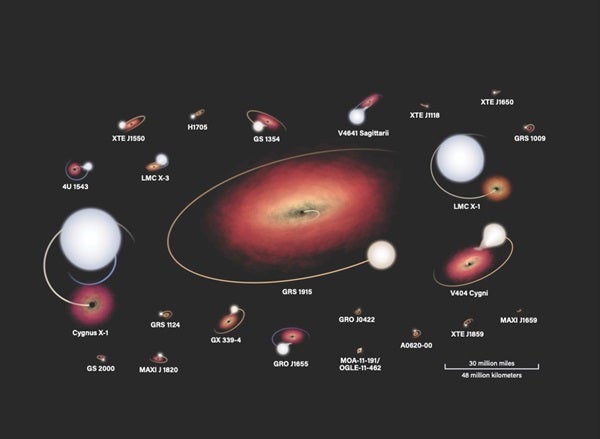
Dark secrets
In addition to studying rogue stellar-mass black holes, astronomers are also trying to piece together the history of their more massive counterparts, with consequences for the history of the universe.
We’ve learned that nearly every galaxy in the cosmos hosts a supermassive black hole at its center. In the early universe, some of these behemoths released torrents of high-energy light as they gobbled up surrounding material. Astronomers have detected more than 100,000 of these objects, called quasars — but these exist only in the distant past, mostly 2 billion to 3 billion years after the Big Bang. There are none in our local (modern-day) universe. Thus, quasars appear to be a phase supermassive black holes go through early in a galaxy’s life, feasting voraciously for a short time until they exhaust the available food supply as the galaxy settles down.
This brief period dramatically affects the evolution of a galaxy. Jets from a quasar can shut down star formation in its host galaxy, either by completely blowing away material that would have formed stars or by heating any gas that’s left (star formation requires extremely cold temperatures to kick off). But astronomers have yet to unravel the details. “We know that a supermassive black hole can play a major role in shaping its galaxy’s properties, like the birth rate of new stars,” says Kristina Nyland, a radio astronomer at the Naval Research Laboratory in Washington, D.C. “But we don’t understand how that connection has changed over cosmic time, or even how this type of black hole originated in the early universe.”
The fundamental mystery surrounding the origins of supermassive black holes is which came first — the supermassive black hole or its host galaxy.
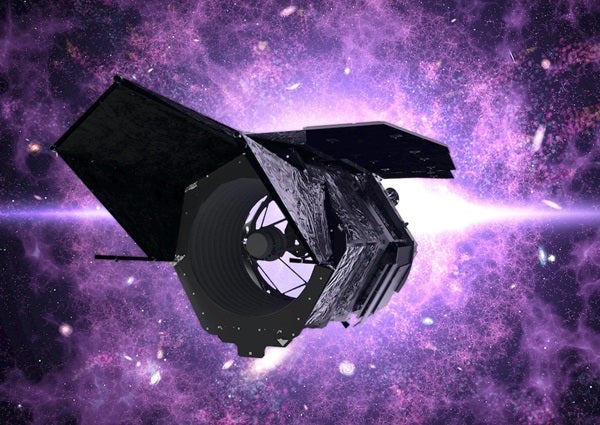
One theory suggests that supermassive black holes formed right alongside their galaxies. As the material that filled the universe began to clump up, the lumpiest parts could have collapsed directly into black holes rather than myriad new stars.
But according to another theory, the heaviest black holes started out as lots of smaller ones. In this scenario, stars packed close together in clusters collided to form extremely massive stars, which ultimately collapsed and became intermediate-mass black holes (a variety that falls anywhere between the stellar-mass and supermassive ones). The clusters, now full of both stars and midsize black holes, would have fallen toward the center of the galaxy and merged to generate ever-larger black holes.
Right now, it isn’t clear which formation pathway is correct. “It could be that there are multiple ways to build a supermassive black hole,” Nyland says.
Much of the uncertainty stems from the fact that so far, astronomers have only identified a handful of intermediate-mass black hole candidates. Although astronomers think they may be common near the centers of dense star clusters or small galaxies, their gravity isn’t strong enough to influence the way nearby stars move as dramatically as supermassive black holes do.
Instead, astronomers have largely had to rely on detecting ripples in the fabric of space-time when intermediate-mass black holes form. The first unambiguous detection came just in 2019: The Laser Interferometer Gravitational-wave Observatory (LIGO) and Virgo interferometer both picked up gravitational waves created when two distant black holes, weighing 85 and 66 solar masses, smashed into each other. The resulting black hole was 142 times the mass of our Sun, placing it squarely in intermediate-mass territory.
Unfortunately, based on the lack of gravitational-wave detections of intermediate-mass black holes since, they don’t seem to be found in binary systems very often, unlike nearly all the stellar-mass black holes discovered so far. And relying on gravitational waves has another disadvantage: These ripples are affected by distance. The farther we are from the source, the weaker the signal we’ll receive. That means any sample of black holes we have is biased toward nearby sources, and some mergers are altogether undetectable.
Black Hole Planets
Among the objects that NASA expects its powerful Nancy Grace Roman Space Telescope to reveal are not only rogue black holes, but maybe even planets orbiting black holes.
“The first exoplanets were discovered around a neutron star,” says Jeremy Schnittman, an astrophysicist at NASA’s Goddard Space Flight Center in Greenbelt, Maryland. “So why not black holes? I think the most likely case would be a binary system made up of a black hole and a ‘normal’ star companion, and then planets orbiting around either the black hole, the star, or both.” If such a system exists, he says, “detecting it would be relatively simple, just like detecting and studying exoplanets transiting in front of their host stars, which we have done for thousands of systems already.” — A.B.V.
By the late 2030s, astronomers hope to be making even more gravitational-wave measurements. The European Space Agency is leading the Laser Interferometer Space Antenna (LISA) mission, a trio of spacecraft that will orbit the Sun 1.6 million miles (2.5 million km) apart. This incredibly long baseline will allow astronomers to study black holes in ways that ground-based interferometers can’t, by detecting gravitational waves with wavelengths too large (i.e., frequencies too low) for Earth-based observatories to pick up. This includes gravitational waves from the mergers of intermediate-mass black holes. (LISA will also see events such as two supermassive black holes merging, as well as instances where a stellar-mass black hole spirals into a supermassive black hole.)
The key to solving many of the mysteries surrounding black holes may lie in multi-messenger astronomy, which pairs different types of observations, such as light and gravitational waves. Such data reveal far more than we could learn from any single type of observation, giving us a more complete picture of celestial objects and phenomena by looking at how they behave in more ways than just how they give off — or affect — light.
“As is so often the case when it comes to science, the more we learn, the more questions we seem to have,” Sahu says. “There’s no single discovery that’s going to clear up all the open questions we have surrounding black holes, but each small finding we make will move us that much closer to understanding the underpinnings of this beautiful universe we live in.”









